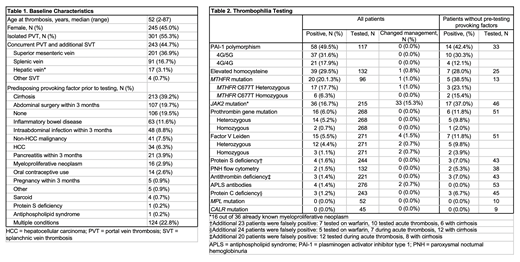Introduction: Patients with portal vein thrombosis (PVT) are frequently referred to hematology for hypercoagulable evaluation. The prevalence of identifiable thrombophilic conditions in patients with PVT is not well reported and the clinical impact of thrombophilia testing is unknown.
Methods: We conducted a retrospective review of patients at a single tertiary care center. Patients were identified who had a documented PVT with or without concurrent thrombosis in additional splanchnic vessels, followed between 1/1/2000 and 5/1/2019 with at least 3-month follow-up available. Exclusion criteria included liver transplantation within 6 months of PVT and inadequate documentation. Changes in clinical management were determined by chart review and determination of documented change in choice, dose, or duration of anticoagulant, future thromboprophylaxis, or counseling of asymptomatic family members as documented in the medical chart.
Results: Baseline characteristics of the entire cohort are summarized in Table 1. Five-hundred and forty-four unique patients were identified. Most patients had an isolated PVT (55.3%). The most common concurrent vessel thrombosed was the superior mesenteric vein (36.9%). Cirrhosis was the most common predisposing provoking condition, followed by recent abdominal surgery and inflammatory bowel disease. Of note, 106 patients (19.4%) had no identifiable underlying provoking factor.
Two-hundred ninety-one patients (53.5%) had at least one hypercoagulable laboratory test performed, with a median number of 8 tests (Table 2). PAI-1 polymorphism was the most common positive thrombophilia test, followed by MTHFR mutation and an elevated homocysteine. Of note, these three test abnormalities have not been consistently linked to increased thrombotic potential. Identification of a JAK2 mutation was noted in 16.7% of patients tested and was detected in 37% of patients without a predisposing provoking factor prior to testing. No patients harbored a mutated CALR and MPL.
In patients without a predisposing provoking factor who had thrombophilia testing performed (n=98), thrombophilia testing was positive in 59 patients (60.2%). Of note, 39 patients (40.0%) of these patients had a negative thrombophilia evaluation.
In patients with thrombophilia testing (n=291), only 41 (14.1%) patients had a test result which impacted management. By far the most common positive-management altering test was JAK2 mutational testing, with 33 patients receiving further workup including a bone marrow biopsy and/or treatment of an underlying MPN as a result of testing. One patient who was diagnosed with paroxysmal nocturnal hemoglobinuria (PNH) received treatment with eculizumab. Two patients with antiphospholipid antibody syndrome were specifically administered coumadin as a result of testing. One patient with Factor V Leiden was anticoagulated for a longer duration, two received thromboprophylaxis during subsequent high-risk situations (which may have been done regardless of Factor V Leiden mutation), and one had screening performed on an asymptomatic family member. One patient with MTHFR mutation and elevated homocysteine received folate supplementation.
Conclusions: These results demonstrate that nearly all hypercoagulable laboratory testing in patients with PVT is not of clinical utility. The most notable exception is JAK2 mutational testing, which appears to be an essential component in the workup of PVT without an obvious provoking factor both because of its relatively high frequency of occurrence and its significant impact on clinical management. In addition, while PNH and APLS are rarely positive in thrombophilia evaluation of PVT, they likely merit evaluation in appropriate clinical settings given their potential to meaningfully impact management. Extensive thrombophilia testing does not appear to reliably impact management.
Kremyanskaya:Incyte, Celgene, Constellation, Protagonist.: Research Funding; La Jolla: Consultancy.
Author notes
Asterisk with author names denotes non-ASH members.


This feature is available to Subscribers Only
Sign In or Create an Account Close Modal